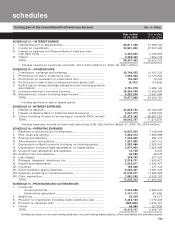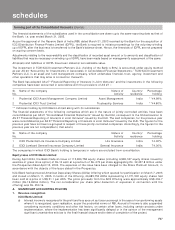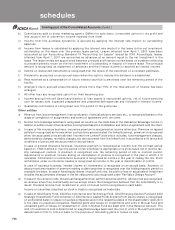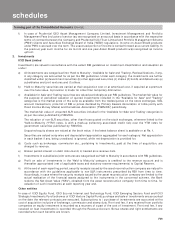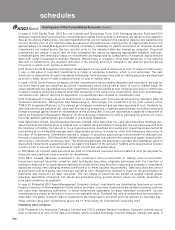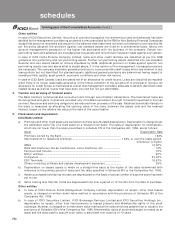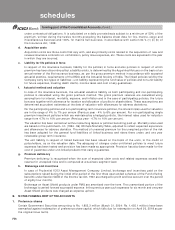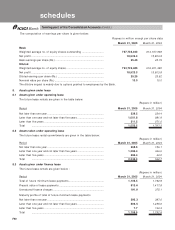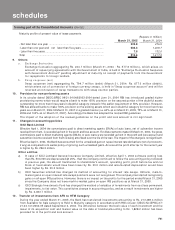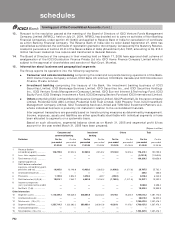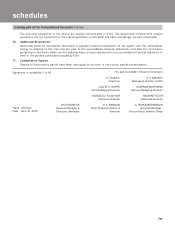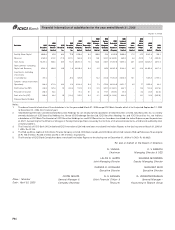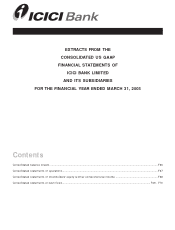ICICI Bank 2005 Annual Report Download - page 115
Download and view the complete annual report
Please find page 115 of the 2005 ICICI Bank annual report below. You can navigate through the pages in the report by either clicking on the pages listed below, or by using the keyword search tool below to find specific information within the annual report.
F55
After impairment, depreciation is provided on the revised carrying amount of the assets over its remaining useful
life. A previously recognised impairment loss is increased or reversed depending on changes in circumstances.
However the carrying value after reversal is not increased beyond the carrying value that would have prevailed by
charging usual depreciation if there was no impairment. As on March 31, 2005 there were no events or changes in
circumstances, which indicate any impairment in the carrying value of the assets covered by AS 28.
12. Accounting for contingencies
The Bank estimates the probability of any loss that might be incurred on outcome of contingencies on the basis of
information available up to the date on which the financial statements are prepared. A provision is recognised when
an enterprise has a present obligation as a result of past event and it is probable that an outflow of resources will be
required to settle the obligation, in respect of which a reliable estimate can be made. Provisions are determined
based on management estimate required to settle the obligation at the balance sheet date, supplemented by
experience of similar transactions. These are reviewed at each balance sheet date and adjusted to reflect the
current management estimates. In cases where the available information indicates that the loss on the contingency
is reasonably possible but the amount of loss cannot be reasonably estimated, a disclosure is made in the financial
statements. In case of remote possibility neither provision nor disclosure is made in the financials.
13. Earnings per share
Basic and diluted earnings per share are calculated by dividing the net profit or loss for the period attributable to
equity shareholders by the weighted average number of equity shares outstanding during the period. Diluted
earnings per equity share has been computed using the weighted average number of equity shares and dilutive
potential equity shares outstanding during the period, except where the results are anti-dilutive.
14. Cash and cash equivalents
Cash and cash equivalents include cash in hand, balances with RBI, balances with other banks and money at call and
short notice.
15. Others
a. Reinsurance premium of insurance business
In case of general insurance business, insurance premium on ceding of the risk is recognised in the year in
which the risk commences. Any subsequent revision to premium ceded is recognised in the year of revision.
Adjustment to reinsurance premium arising on cancellation of policies is recognised in the year in which it is
cancelled. In case of life insurance business, reinsurance premium ceded is accounted in accordance with the
treaty or in-principle arrangement with the reinsurer.
b. Claims and benefits paid
In case of general insurance business, claims comprise claims paid, estimated liability for outstanding claims
made following a loss occurrence reported and estimated liability for claims Incurred But Not Reported ('IBNR')
and claims Incurred But Not Enough Reported ('IBNER'). Further, claims incurred also include specific claim
settlement costs such as survey / legal fees and other directly attributable costs.
Claims (net of amounts receivable from reinsurers/coinsurers) are recognised on the date of intimation of the
loss.
Estimated liability for outstanding claims at Balance Sheet date is recorded net of claims recoverable from/
payable to co-insurers/reinsurers and salvage to the extent there is certainty of realisation. Estimated liability
for outstanding claims is determined by management on the basis of ultimate amounts likely to be paid on each
claim based on past experience. These estimates are progressively revalidated on availability of further
information.
IBNR represents that amount of claims that may have been incurred during the accounting period but have not
been reported or claimed. The IBNR provision also includes provision, if any, required for claims IBNER.
IBNR/IBNER liabilities are based on an actuarial estimate duly certified by the Appointed Actuary of the company.
In case of life insurance business, claims other than maturity claims are accounted for on receipt of intimation.
Maturity claims are accounted when due for payment. Reinsurance on such claims is accounted for, in the same
period as the related claims. Withdrawals under linked policies are accounted in the respective schemes.
c. Reserve for unexpired risk
Reserve for unexpired risk is recognised net of reinsurance ceded and represents premium written that is
attributable and to be allocated to succeeding accounting periods for risks to be borne by the company
schedules
forming part of the Consolidated Accounts (Contd.)


